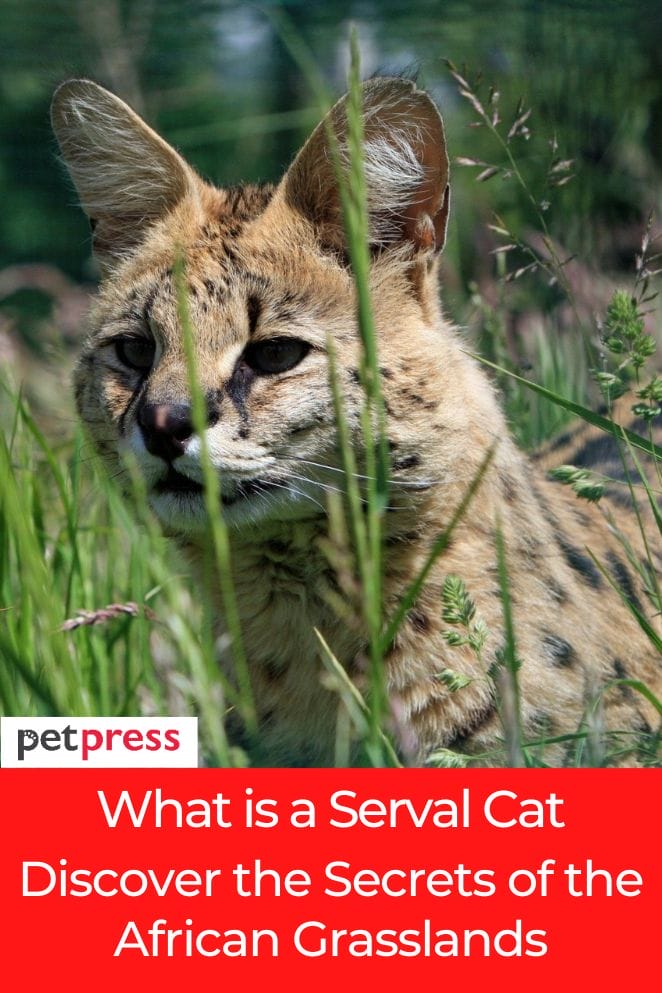
In the domain of extraordinary wild felines, the Serval cat reigns as a captivating and mysterious creature.
Its striking visage and intriguing behaviors have piqued the curiosity of numerous animal enthusiasts.
This article takes a deep dive into the world of Serval cats, unraveling their origins, characteristics, and the exceptional traits that distinguish them from other feline species.
The Origins of the Serval Cat
The Serval cat (Leptailurus serval), an entrancing and captivating feline, traces its roots to the vast grasslands and savannas of Africa.
Across countries like South Africa, Senegal, Tanzania, and Ethiopia, this agile creature has evolved to flourish in diverse landscapes.
With its lithe physique, elongated legs, and prominent ears, the Serval cat exhibits remarkable dexterity and elusiveness, effortlessly traversing various terrains.
Its unique adaptations have honed it into an exceptional predator, adept at hunting in both open grasslands and densely vegetated areas.
Adorned with a coat of golden-yellow fur, embellished with bold spots and stripes, the Serval cat emerges as an iconic symbol of African wildlife, embodying nature’s incredible adaptability and resilience.

The Physical Characteristics of the Serval Cat
Native to the African grasslands, the Serval cat boasts a renowned appearance and exceptional adaptability.
Its lithe and sleek body, coupled with elongated legs, enables swift and agile movements, rendering it a remarkable hunter.
The Serval cat’s large, rounded ears grant it exceptional auditory prowess, allowing it to detect even the faintest sounds of its prey.
Its alluring golden-yellow fur, embellished with bold spots and stripes, not only enhances its beauty but also provides superb camouflage amidst its natural habitat. W
ith a long neck and small head, the Serval cat embodies an elegant and captivating silhouette, a mesmerizing sight in the wild.
The Behaviors and Habits of the Serval Cat
With their captivating allure and perceived resemblance to domestic cats, Serval cats may initially intrigue some individuals as potential pets.
However, it is fundamental to fathom that Serval felines are wild creatures, portrayed by exceptional requirements and ways of behaving that contrast with normal trained cats.
The prosperity of these sublime animals requires particular consideration, including an open and enhanced environment, a painstakingly adjusted diet, and regular mental and physical stimulation.
It is crucial to acknowledge that in many regions, owning a Serval cat as a pet may be restricted or even unlawful due to conservation concerns and the distinctive challenges associated with their responsible care.
By respecting the wild nature of Serval cats, we contribute to their well-being and the preservation of their natural habitats.

The Serval Cat as a Pet
In light of their captivating allure and apparent resemblance to domesticated cats, some individuals are initially enticed by the prospect of having a Serval cat as a pet.
Nevertheless, it is imperative to acknowledge that Serval cats are untamed creatures with distinctive needs and behaviors that may not align with those of typical domestic felines.
These remarkable beings necessitate specialized attention, including an expansive and enriched environment, a meticulously balanced diet, and regular mental and physical engagement to thrive.
It is noteworthy that in numerous regions, the ownership of a Serval cat as a pet might be subject to restrictions or even considered illegal, owing to conservation concerns and the distinctive challenges linked to their responsible care.
By comprehending and honoring the inherent wildness of Serval cats, we can ensure their welfare and contribute to their preservation in their natural habitats.
Conservation Efforts and Status
The Serval cat, a diminutive African wildcat celebrated for its distinctive coat and elongated limbs, finds itself entangled in a web of threats that cast a shadow over its population.
The encroachment of human development and the relentless march of deforestation, coupled with the illicit trade in its prized fur and the clandestine commerce of exotic pets, presents an intricate labyrinth of challenges that pose a real danger to the survival of this exceptional species.
However, amidst this perplexing story, the International Union for Conservation of Nature (IUCN) takes an apparently mixed-up position, marking the Serval feline as an animal of “Least Concern” on the sweeping material of protection prioritization.
However, this incomprehensible classification doesn’t weaken the earnestness of the source of inspiration.
Entities and fervent wildlife sanctuaries labor unwaveringly in a symphony of dedicated efforts to shield and conserve the Serval cat, ensuring its perpetual presence in the untamed domains for posterity to revere and safeguard.

Conclusion
The Serval cat, a creature of fascination and wonder, exhibits an extraordinary ability to thrive in the vast expanse of the African savanna.
With its distinctive physical attributes, prowess in hunting, and enigmatic behaviors, it stands as a truly exceptional member of the feline family.
As our quest to unravel the complexities of these remarkable beings continues, it is incumbent upon us to unite in collaborative endeavors to ensure their perpetual existence for the forthcoming generations to cherish and protect.
FAQs
While some individuals may be tempted to keep a Serval cat as a pet, it is essential to remember that they are wild animals with unique needs and behaviors. In many regions, owning a Serval cat as a pet may be restricted or illegal.
Serval cats are skilled hunters and primarily prey on small rodents, birds, and insects. Their diet may occasionally include reptiles and fish.
The Serval cat population faces threats, but they are currently classified as “Least Concern” on the conservation status scale by the International Union for Conservation of Nature (IUCN).
Serval cats inhabit the grasslands and savannas of various African countries, including South Africa, Senegal, Tanzania, and Ethiopia.
The Serval cat hunts primarily at night, using its keen sense of hearing and sharp vision to locate and pounce on its prey with remarkable speed and precision.


GIPHY App Key not set. Please check settings